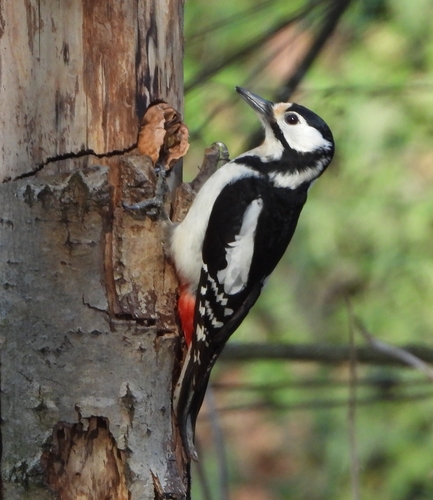
Great Spotted Woodpecker
The Great Spotted Woodpecker (Dendrocopos major) is a widespread and easily recognizable member of the woodpecker family. Known for its striking black, white, and red plumage, it plays a crucial role in forest ecosystems by controlling insect populations and creating nesting cavities used by other species. It is a highly adaptable bird, found in a variety of wooded habitats across Eurasia. While not currently considered globally threatened, localized declines have been noted in some areas due to habitat loss. It holds no particular major cultural significance, but its distinctive drumming sound is a familiar and welcome sign of spring in many regions.
20-24 cm
Length
34-39 cm
Wingspan
Least Concern
Conservation Status
Distribution
The Great Spotted Woodpecker has a vast range, extending across Europe and northern Asia, from the British Isles and the Iberian Peninsula in the west to Japan and eastern China in the east. It is also found in parts of North Africa. Its altitudinal range varies, occurring from sea level to the tree line in mountainous regions.
Lifespan
Up to 11 years in the wild, though average lifespan is likely shorter.
Great Spotted Woodpecker's Habitat
Habitat Types
Coniferous forests, Deciduous woodlands, Mixed forests, Parks, Gardens with mature trees
Climate Zones
Temperate, Boreal, Subtropical (in parts of its range)
Adaptations
Strong, pointed bill for excavating wood; zygodactyl feet (two toes pointing forward, two backward) for secure grip on tree trunks; stiff tail feathers for support while climbing; long, barbed tongue for extracting insects from crevices.
Variations
Numerous subspecies have been described, differing subtly in plumage coloration and size. For example, *D. m. pinetorum* is found in central Europe, while *D. m. japonicus* occurs in Japan.
Appearance
Breeding Plumage
Little to no difference between breeding and non-breeding plumage.
Seasonal Feather Changes
Minimal seasonal variation; plumage may appear slightly duller after molting.
Sex Based Plumage Differences
Males have a red patch on the nape (back of the neck), which is absent in females. Juveniles have a red crown, which is lost as they mature.
Notable Features
Bold black and white patterning on the back and wings., Red undertail coverts., White cheeks and underparts., Strong, chisel-like bill.
Diet and Feeding
Primary Foods
Insects and their larvae, Seeds (especially pine and other conifer seeds), Nuts, Berries, Occasionally, eggs and nestlings of other birds
Foraging Behavior
Forages primarily on tree trunks and branches, using its strong bill to excavate wood and extract insects. It also gleans insects from the surface of bark and foliage. Will visit bird feeders, especially for suet and nuts.
Specializations
The skull is specially adapted to withstand the repeated impacts of drumming. The tongue is long and sticky, with barbs at the tip, allowing it to extract insects from deep within crevices.
Seasonal Diet Variations
Diet shifts with seasonal availability. Insects are the primary food source during the breeding season, while seeds and nuts become more important in autumn and winter.
Behavior
Social Structure
Generally solitary or in pairs outside the breeding season. During the breeding season, pairs defend a territory around their nest site.
Communication
Loud, sharp 'kik' call., Drumming on resonant surfaces (a rapid series of strikes with the bill)., Rattling calls during courtship and territorial disputes.
Migration
Mostly resident, but some northern populations may undertake short-distance migrations or irruptive movements in response to food shortages.
Territorial or Group Behaviors
Highly territorial during the breeding season, defending their nest site and foraging area from other Great Spotted Woodpeckers. Drumming serves as a territorial advertisement and a means of attracting a mate.
Conservation
Threats
Habitat loss and fragmentation due to deforestation and urbanization., Loss of mature and dead trees, which are essential for nesting., Intensification of forestry practices (removal of dead wood).
Protection Programs
Protected under various national and international wildlife laws., Habitat restoration and management initiatives., Provision of artificial nest boxes in some areas.
Local National Laws
Protected under the Wildlife and Countryside Act 1981 in the UK, and similar legislation in other European countries.
Population Trend
Stable
Population Estimates
The global population is estimated to be between 73.5 million and 140.9 million mature individuals.
Interesting Facts
They can drum at speeds of up to 20 strikes per second.
This rapid drumming is used for communication, not just for excavating food.
Their brain is protected from the impact of drumming by special adaptations.
These include a spongy bone structure in the skull and a tight fit between the brain and skull.
The Great Spotted Woodpecker's tongue wraps around its skull.
This unusual anatomy helps to cushion the brain during drumming and allows the tongue to extend far out to reach insects.
Great Spotted Woodpeckers are known to occasionally predate on the nests of other birds.
They will sometimes break into nest boxes or natural cavities to eat eggs and nestlings.
Faqs about Great Spotted Woodpecker
What is the difference between a male and female Great Spotted Woodpecker?
Males have a red patch on the nape (back of the neck), while females do not.
Do Great Spotted Woodpeckers migrate?
Most Great Spotted Woodpeckers are resident, but some northern populations may move south in winter if food becomes scarce.
What should I do if I find a Great Spotted Woodpecker nest?
Observe the nest from a distance and avoid disturbing the birds. It is illegal to intentionally damage or destroy the nest of any wild bird.
How can I attract Great Spotted Woodpeckers to my garden?
Provide a source of food, such as suet, peanuts, or sunflower seeds. Leaving dead or decaying trees standing (if safe to do so) can also provide nesting opportunities.
Are Great Spotted Woodpeckers harmful to trees?
While they do excavate holes in trees, Great Spotted Woodpeckers primarily target dead or decaying wood, playing an important role in decomposition and nutrient cycling. They rarely cause significant damage to healthy trees.
Copyright @ Nature Style Limited. All Rights Reserved.
 English
English